该项目已获得2013年ASLA Student Awards Hornor Awards (General Design Category)
详见:http://www.asla.org/2013studentawards/649.html
Project Statment | 项目陈诉
“Migrating Beyond Boundaries” seeks to use the existing ecological rhythm of bird migration through the Great Rift Valley as a catalyst for the construction of a new shared ground within the deeply divided geopolitical landscape of Israel’s Kidron Valley. The creation of ecological infrastructure for migrating birds, protects and improves the lives of all. The intersection of the natural and cultural are amplified to open previously inaccessible parts of the valley, creating place where Israelis and Palestinians can connect with each other through an appreciation of their shared landscape and ecology.
“飞越边界”从已有的东非大峡谷鸟类迁徙生态现状中寻求一种突破,来为长久以来被历史政治以及地理特征分裂开来的汲沦谷两岸人民创造一个共生空间。 通过为这些庞大数量的迁徙鸟类恢复与创造栖息地,从而改善水,土,与两岸民众的生活状态。关注自然与文化的交汇,联系之间山谷里无法触及的区域,通过共享景观的价值来为以色列和巴勒斯坦人民长久的隔阂创造对话空间。
Site | 场地
The project territory is the Kidron Valley, which stretches from the eastern side of Jerusalem’s Old City to the Dead Sea and the Great Rift Valley. The valley drops 4000 feet, through both Israeli and Palestinian territories, along its 20 mile course. Through it, runs the once seasonal Kidron River; now running year-round due to the daily flow of untreated sewage it collects. The valley’s water and land is further poisoned by garbage and runoff from agricultural pesticides.
汲沦溪谷(图 1),作为东非大峡谷的一个部分,从耶路撒冷城以东蜿蜒至死海。 整个溪谷高差四千英尺,延绵二十英里,交错跨越在以色列和巴勒斯坦疆域范围。汲沦河,作为主要项目研究对象,曾经为季节性河流,如今成为常年的未处理污水排放河道。水与土地都遭受了垃圾以及农业排污的地面径流污染。
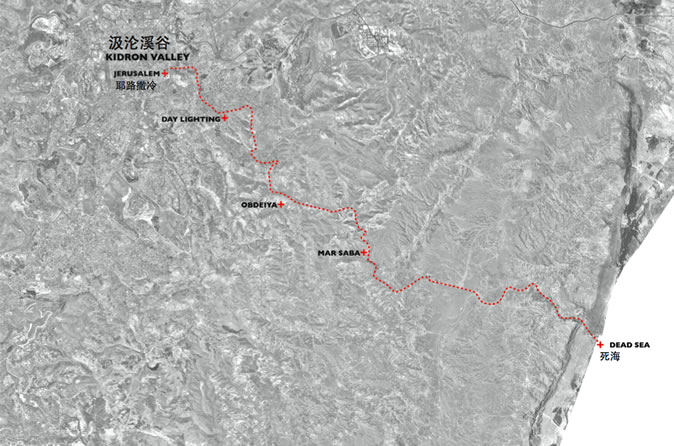
图1 汲沦溪谷 耶路撒冷
Greater Ecological Rhythms + Opportunities 更大的生态节奏 + 机遇
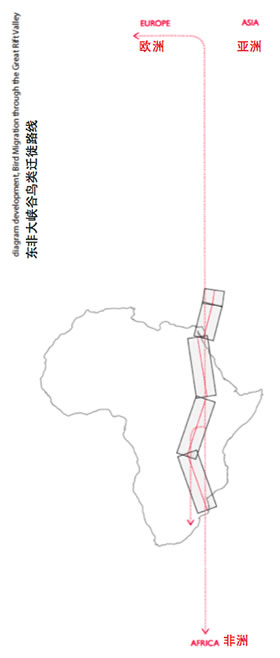
图2
We recognized the Kidron as one of a larger rhythm of valleys that extend off the massive Great Rift Valley. Approximately 4000 miles in length, this massive geological fault connects central Mozambique to Turkey. It is recognized as one of the world’s most important and species diverse routes for migratory birds. A quarter of the world’s birds travel through the Great Rift Valley to from Africa to Eurasia twice a year.
汲沦山谷以更宏大东非大峡谷为背景(图 2)。东非大峡谷由大规模的断层组成,延伸四千英里,连接了莫桑比克中部与土耳其。这个区域被认为是世界最重要鸟类迁徙途径。丰富的种群,约占世界总迁徙数量四分之一的鸟类每年两次跨越东非大峡谷,穿行在东亚与非洲之间。
Israel’s position as a land bridge between the three continents makes the country a crucial and hazardous part of their journey. The convergence of 500 million birds through a country slightly smaller than New Jersey (twice a year), greatly amplifies the threats they face throughout their migration: poisoning from polluted water, loss of habitat, and desertification. And yet, their movements seem miraculous, moving freely through a country with so many boundaries. Understanding the threats are shared with the people of the Kidron, we recognized their potential as catalysts for the interventions that would benefit all: birds and people, both Israeli and Palestinian.
以色列地处三大洲之间的狭窄的大陆桥(图3),是迁徙鸟类的重要途径区域,,在这里它们的生命经受着严峻的考验。 作为一个国土疆域范围比新泽西州略小的国家,每年有超过 500,000,000只鸟儿从上空飞过。虽然水源污染,栖息地消失,和沙漠化都威胁了它们的迁徙。 然而,它们仍能自由地穿越如此重重边境与界限,在我们看来这是能够使两岸 产生共鸣的神圣力量。这些迁徙的鸟儿是汲沦溪谷人们所共同享有的,不关种族与政治,无论他是以色列人还是巴勒斯坦人。 我们认为它们或许可以成为一个跨越边界的催化剂,通过为这些鸟儿创造更好的生态环境,来融通汲沦山谷两岸的人民。
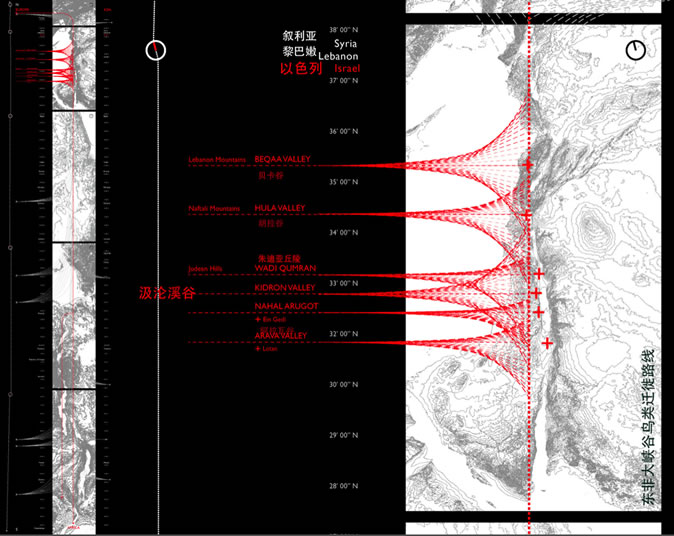
图3 东非大峡谷鸟类迁徙路线
Design Process / Construction of a New Ground | 设计过程/设计语言
Working first through models, or material splices, a design language was created to allow for a new reading of the Kidron. With the movements of the birds in mind, our splice operations were deployed to create new interactions between birds and people.
首先,我们开始寻找一种解读场地的设计语言,通过材料或者模型的拼接重组这种具体的方式来寻求答案,以此找到一种可以运用在解读和表达鸟类和人类互动关系的方式。
Splicing 拼接(定义)
Splicing is to insert seamlessly, seamlessly meaning not that the insertion“fit”a context, but rather “makes” a new ground a new imaging and imaging, here and there, this and that, now and then. In this sense, a splice is something that takes over. Design as an act of splicing demands that designer take responsibility for the extended reach of a splice, the ground that it makes.”
The operation of out initial material splices became a design language.
拼接是指无缝地接入,然而这个接入并非说为了“适应”所接入的背景,而是去“创造”出一个 新的背景,新的图像,新的时间与空间。设计就是一个拼接过程,这需要设计师能够驾驭这个拼接所产生的结果。
Material Splicing 拼接手法 :
Weaving 编织
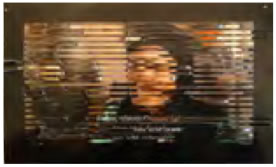
图4
The film To Die in Jerusalem, documents the two mothers (one Palestinian + the other Jewish). They were strangers whose lives were spliced together in the wake of a suicide bombing which claimed the lives of both their daughters (one was the bomber and the other a victim of the attack). Due to political climate, they were unable to meet face to face. Screens of this conversation were divided into the distinct physical space. A number of frames caught both sides in the same second, and these became the basis of the splice. Using these shared moments, I worked to extend these spaces by physically weaving frames together. These shared frames offer a new ways to look at extending common ground in a highly divided country.
电影《圣城的女儿》纪录了两个莫不相识的母亲因为一起自杀式炸弹袭击而相遇的对话,分别为自杀者与受害者的母亲。然而政治气候却不容许两个女人面对面的交谈。他们被分隔在不同的空间里谈话。我提取了在相同时间轴里同时出现了两者的画面,以这些共有的画面为起点,用编织衍生出更广的空间。这些共同的画面为一个高度分裂的国度找到一个共生空间。(图4)
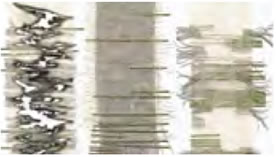
图5
Intersection/ Extraction 抽出/插入
This splicing operation is insertion/extraction on the existing ground (fabric). Using this operation to study the
materiality of the ground conditions, as well as the possibilities and limitations that created by the actions. These creates and gradient and rhythm on the original ground. The melting and loosing create topographic changes of the ground. The material splicing test the operation that can be applied on the site, and provides unlimited possibilities prompt for future design, and tangible result can be read and interpreted.
从对材料的探索中, 得到另外一种拼接手法:插入与抽出,通过这种手法来编辑现存的场地状态(纺织物), 试验如何可以突破材料的物理局限而获得更多可能性。抽出原有的纬线,插入新的材料来获得结构的稳固,从而创造出材料的韵律与节奏,也使材料具有了三维地形特征。这种材料的试验提供了一种可以代入到场地里的思考方式,也提供了一种可以更具象的解读场地的参照。(图5)
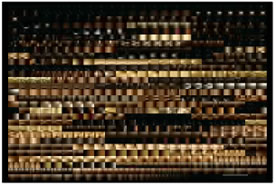
图6
Compression/ Expansion 压缩/延展
These are screens of film edited by the splicing operation of compression and expansion. Focusing on lighting condition, through these actions, the original ground are been shifted, realigned, and transited into new ground.
在这组图像中,通过压缩和延展这个动作来改变了原有图像的特质。通过对光影的分析上,这种拼接动作使图像移动,替换,重组,从而衍生了新的图像。(图6)
Photowork 图像处理
A photowork represents the resulting rereading of the Kidron as a progression of the valley through the essential elements of air, water, and earth from Jerusalem to the Dead Sea. The movements, nesting preferences, and seasonality of birds, both migrant and resident, are woven through the essential elements of the Kidron, as represented by our photoworks. These drawings combine to create new shared ground for birds and people.
我们通过用照片拼接处理的方式来解读场地(图7)。这里表现了汲沦河从耶路撒冷城流入死海这整 个场地三个重要的元素: 空气,水与土地之间关系。这三种元素在这个图像中分别位于上、中、下部分,图像也正对应了相应的现实空间关系和地理形态。这三组照片的拼接方式运用了之前对“拼接手法”的研究,分别为编织(空气),插入/抽出(水),压缩/延展(土地)。在这基础之上,将鸟类(包括了常驻类和迁徙类)的行为习性,季节性,和筑巢性都融入到场地里这三个元素中。 以此归纳人与鸟的关系,提取场地精神,提炼出一个有别与真实场地的人与鸟共生的“新场地”。
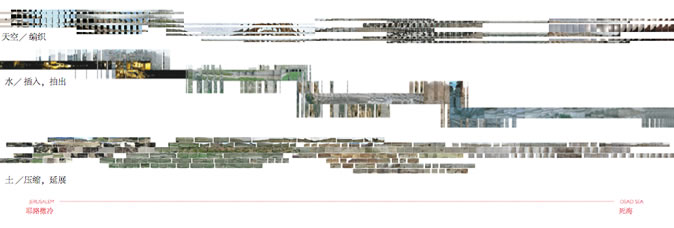
图7
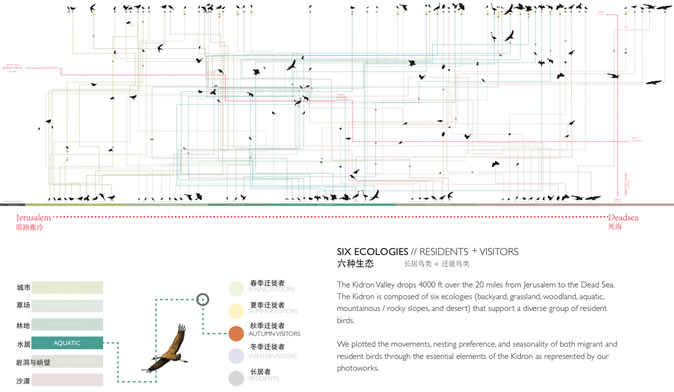
图8
汲沦山谷从耶路撒冷到死海之间高差4000英尺跨度20英里。 这个区域由六个生态环境组成(城市,开敞场地,水域,山地/岩山,沙漠),这些为多种的鸟类种群提供了栖息地。
这张图上显示以这几种鸟类栖息地为分类的的行动方向,筑巢习性,栖息地特征等等。
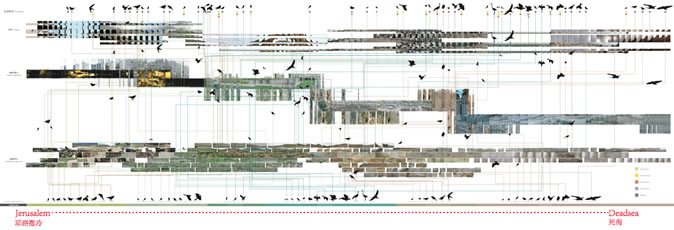
图9
Areas of concentration are revealed as the greatest opportunities for change and becomes the ground for two hand drawings that explore the generative potentials of each element and their programmatic opportunities. From the intersection of air and earth, we projected opportunities for education, research, recreation, and a less toxic form of agriculture for the region. Responding to specific sites along the Kidron, such as its daylighting and use for agricultural around the Dead Sea, drawings projected moments for water purification through treatment wetlands, designed to maximize education and research opportunities as well as habitat and nesting for birds.
以上的照片拼贴集中表达了我们认为可以最可以揭示场地机遇的部分。这个“新场地”成为之 后两张手绘图的基础,来探索每个元素的可能性。从空气与土地两个元素中(图9),一系列项目发展出来:教育,研究,娱乐与区域的生态农业。在汲沦山谷的具体场地中,如耶路撒冷城的地下水管道出水口区域和死海附近区域中,可以成为特定的农业项目。从水这个元素发展而来(图10),探索了一系列项目通过水处理与湿地管理,衍生了教育研究,鸟类栖息地生态重建等项目。
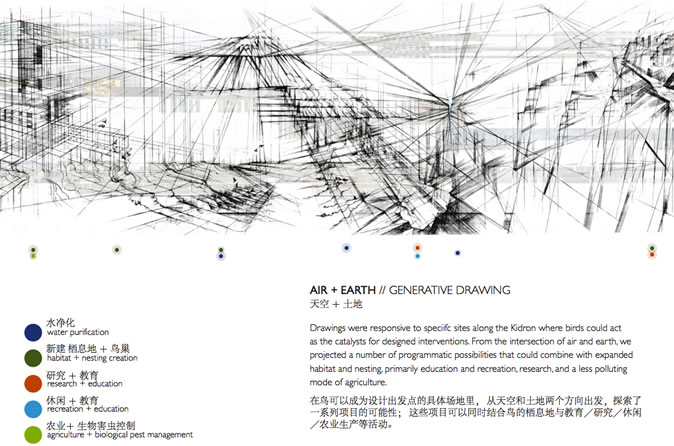
图10

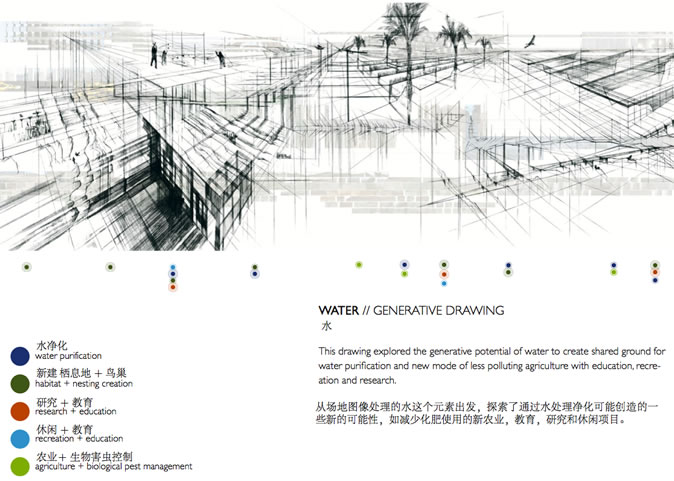
图11
These drawings became the blueprints for an iteration models based on different intersections of human program and bird movement: cave, columbarium and bridge. The expansion of existing caves creates opportunities for observation and research of birds migrating through the Great Rift Valley. Building on historic regional tradition of columbariums, structures that provide nesting for large numbers of birds, a new typology provides nesting while also functioning as structural support for roadways, bridges and buildings. A free standing columbarium concentrates nesting so that bird guano can be collected and used as agricultural fertilizer. This new arrangement frees farmers from using chemical pesticides that currently poison water and earth.
这两张探索性手绘图成为之后一系列模型的基础(图12)。 这些模型继续探索更小尺度空间内人和鸟的关系;洞穴,巢龛,桥梁等等。 利用已有的洞穴改造成迁徙鸟类的观测站和研究点。利用当地历史遗留的骨灰龛columbarium(一种构造,一面有很多空间可以为大量的鸟群提供栖息地,另一面可以收集鸟类粪便作为肥料),这种多功能的构造衍生出了其他形态,例如作为道路,桥梁结构支撑的一部分,作为建筑的延伸部分,或者独立结构安置在需要的地方。除了提供栖息地之外,某种程度减少化肥使用对水和土壤的污染。(图 13、14、15、16)
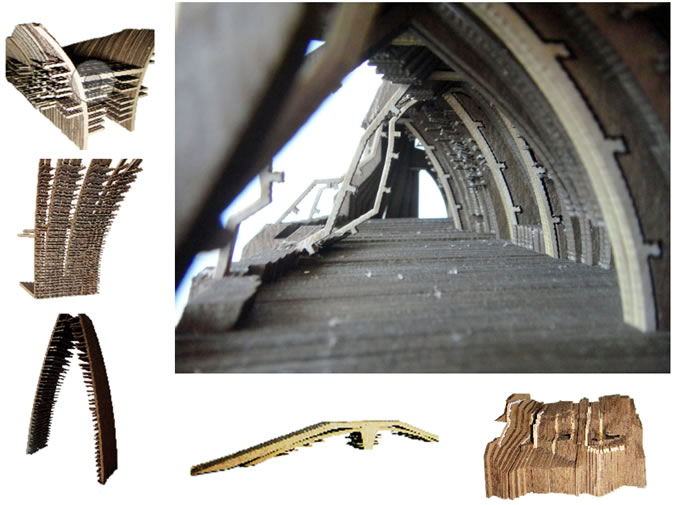
图12
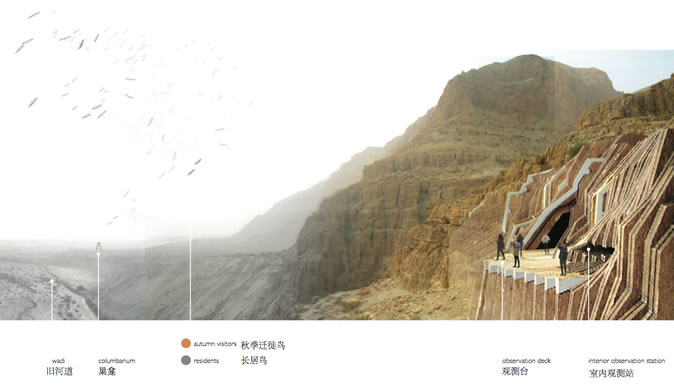
图13
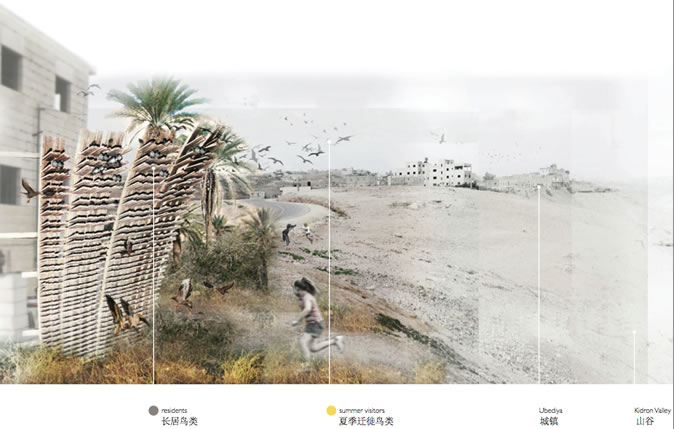
图14
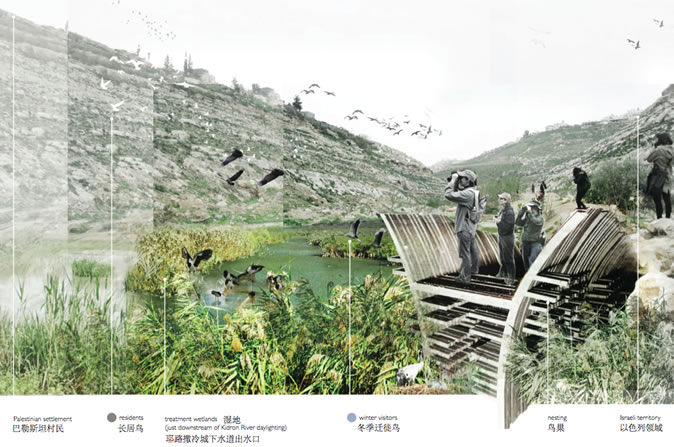
图15
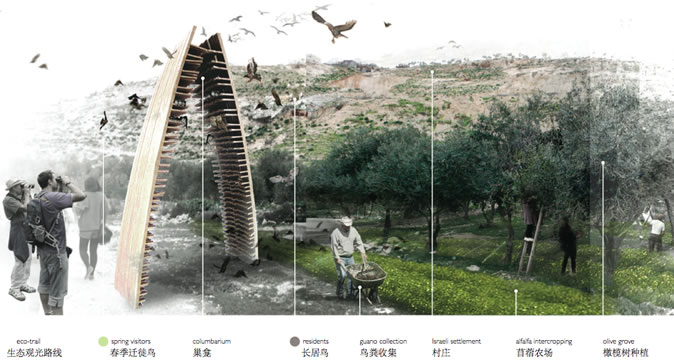
图16

图17
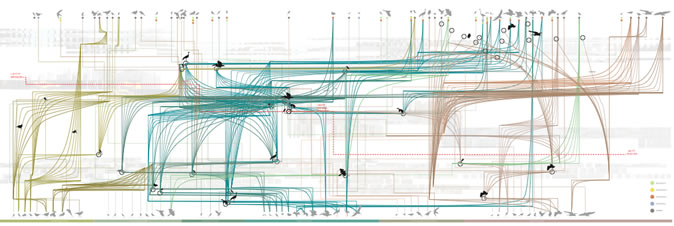
图18
Impact / Influence 冲击/影响
“Migrating Beyond Boundaries” is meant to operate as an alternative vision for catalyzing the necessary changes in the tense and divided Kidron Valley. Through the construction of ecological infrastructure for migrating birds, the lives of all is improved. The project is an example of how an ecological rhythm, such as bird migration, can be used to connect people to each other and to their shared landscape and ecology.
“飞越边界”在于寻求另外一种方式来缓解汲沦山谷两岸紧张的关系。 通过为了迁徙的鸟类和与之共生的人类创造更友好的环境,在生态恢复与改善两岸人民的生活之间形成了良好的共生关系。通过共建生态基础设施,为两岸带来新机遇,来改善人民的生活,跨越政治与历史的纠葛,从“天空”这个更为空旷诗意的领域来创造共同享有的景观与生态,创造更多对话的可能。
